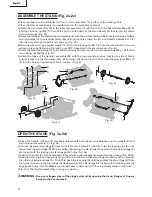
To reduce the risk of electrical shock, double-insulated
tools are equipped with a polarized plug (one blade is
wider than the other). This plug will fit into a polarized
outlet only one way.
If the plug does not fit, contact a qualified
electrician to install a polarized outlet. Do not change the plug in
any way.
Double insulation is a concept in safety in electric power tools, which eliminates the need for the usual
three-wire grounded power cord. All exposed metal parts are isolated from the internal metal motor
components with protecting insulation. Double insulated tools do not need to be grounded.
DOUBLE INSULATION
9
English
WARNING:
The double insulated system is intended to protect the user from shock resulting from a
break in the tool’s internal wiring. Observe all normal safety precautions to avoid electrical
shock.
ELECTRICAL CONNECTION
WARNING:
Do not permit fingers to touch the terminal or the plug when installing or removing the
plug from an outlet.
WARNING:
Double insulation does not take the place of normal safety precautions when operating
this tool.
CAUTION:
Servicing of a product with double insulation requires extreme care and knowledge of the
system and should be performed only by a qualified service technician. For service, we
suggest you return the tool to your nearest authorized service center for repair. Always
use original factory replacement parts when servicing. Do not use power tools in wet of
damp locations or expose them to rain or snow.
Fig. 1
This tool has a precision-built electric motor. It should be connected to a power supply that is 120 volts,
60 Hz, AC only (normal household current). Do not operate this product on direct current (DC). A substantial
voltage drop will cause a loss of power and the motor will overheat. If the tool does not operate when
plugged into and outlet, double check the power supply.
GUIDELINES FOR EXTENSION CORDS
Use a proper extension cord. Make sure extension cords are in good condition. When using an extension
cord, be sure to use a cord that is heavy enough to carry the drawn current needed by the saw. An undersized
cord will cause a drop in line voltage, resulting in loss of power and overheating.
The table below shows the correct size to use, depending on the cord length and nameplate amperage rating.
If in doubt, use the next heavier gauge. The smaller the gauge number, the heavier the cord.










































